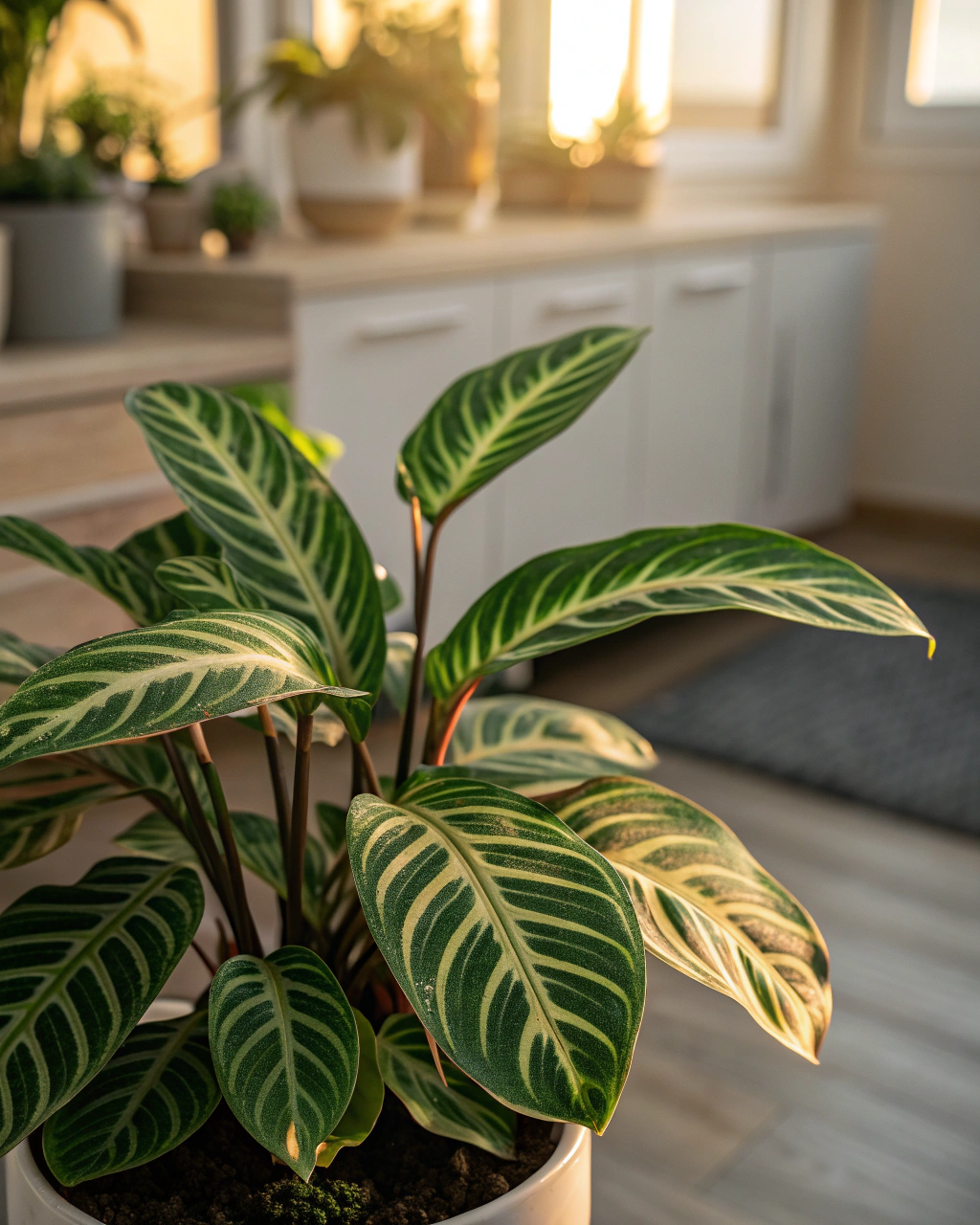Introduction
Calathea plants are a stunning addition to any home or balcony, renowned for their beautifully patterned leaves that seem to shimmer with life. But beyond their good looks, these tropical beauties flourish best when you understand their specific needs—especially their love for humidity. If you’ve ever struggled with curled leaves or brown tips, I’m here to assure you: success is within reach. You don’t need a greenhouse or high-tech gear, just consistency, close observation, and a bit of patience. This guide will walk you through everything you need to know about achieving the perfect humidity level—and much more—to keep your Calathea vibrant, lush, and healthy year-round.
Preparing the Perfect Setup
First, let’s gather the right tools and set a foundation that respects what your Calathea needs. You’ll quickly notice how the correct environment influences leaf texture and growth rhythm. Each element on this list plays a vital role in mimicking the plant’s natural tropical habitat, ensuring your Calathea thrives indoors.
- Pot: Select a container with a diameter about 2 to 4 cm wider than the plant’s root ball. This size allows room for growth but prevents excess moisture buildup. Always choose a pot with adequate drainage holes. A well-draining option, like unglazed clay, helps keep the roots cool and prevents sogginess, which Calathea roots hate.
- Substrate: Create a light, airy mix ideal for moisture retention without suffocation. A blend of about 50% high-quality peat moss or coconut coir (for moisture retention), 30% perlite (for aeration), and 20% pine bark or fine orchid bark works beautifully. Aim for a slightly acidic pH between 5.5 and 6.5, replicating the rich organic soils of tropical forests.
- Light: Provide about 6–8 hours of bright but indirect light daily, roughly 10,000–20,000 lux. Too much direct sun creates faded leaf colors and crispy edges. A sheer curtain will soften incoming rays if placed near a south or west window.
- Humidity: Calatheas demand strong, steady moisture in the air—maintain between 50–70% relative humidity (RH). You can reach this by grouping plants together, setting a pebble tray with water beneath the pot, or using a humidifier, especially in heated or air-conditioned rooms.
- Temperature: Keep daytime temperatures within 18–24°C (65–75°F). At night, avoid letting it drop below 13°C (55°F) because Calatheas are tropical and sensitive to cold drafts.
- Fertilizer: A balanced liquid fertilizer like a 20-20-20 N-P-K formulation works well. Dilute it at a 1:10 ratio and feed your Calathea every 3–4 weeks during the growing season to support leaf development and overall vigor. Consider eco-friendly organic fertilizers as an alternative—they nourish gently and sustain soil life.
Step-by-Step Care Routine
1) Understanding the Plant’s Cycle
Calatheas have a subtle but distinct growth rhythm—you’ll notice new leaves unfurling during warmer months and slower growth or rest during cooler periods. It’s important to respect this cycle, especially during the rest phase when the plant diverts energy to root strengthening and internal maintenance rather than outward growth.
I vividly remember early in my Calathea journey, I kept increasing watering after seeing the leaves droop post-bloom, mistakenly thinking it would revive the plant faster. Instead, it nearly drowned the roots. The leaves yellowed, and the plant became listless. Once I slowed down watering and focused on maintaining humidity and indirect light, the plant revived, showing me that rest is just as crucial as growth in the cycle.
2) The Right Pot and Substrate
Knowing when to repot and which substrate to use makes all the difference for your Calathea’s root health. Before blindly upsizing your pot, gently lift the plant from its container and inspect the roots. Healthy roots are firm and creamy white or pale green; if they’re brown and mushy, it’s time to repot and trim those damaged parts.
Use your fingers to check the substrate: it should feel fluffy and light, not dense or compacted. Calatheas dislike waterlogging and suffocation, so dense potting soil is a common misstep—roots will suffocate, and the plant struggles to breathe. The airy mix described earlier allows water to trickle through evenly, reducing stagnant moisture around roots.
3) Watering the Smart Way
Watering Calatheas correctly can sometimes feel like hitting a moving target, but here’s a reliable method to steady your schedule. Water deeply about once a week or whenever the top 2–3 cm of the substrate feels dry to the touch. Feel the moisture—if it’s still damp, wait a day or two before watering. This prevents root rot and mimics their natural intermittent rain cycles.
Use lukewarm, soft water to avoid shocking the roots or depositing minerals. Rainwater or filtered water with low mineral content is ideal. After watering, always let the excess drain out fully—never allow the pot to sit in standing water, as this encourages root disease.
Seasonally, adjust: reduce watering frequency in winter when the plant is less active, typically to every 10–14 days. In dry summer months or heated homes, you might need to water more often while keeping an eye on substrate moisture.
To gauge watering needs between cycles, try the “weight test”: lift your planted pot when dry and again after watering. The difference in weight helps you intuitively sense when the plant thirsts.
4) Light, Temperature, and Humidity Balance
This trio is the heart of Calathea care. Bright indirect light for 6 to 8 hours daily recreates their forest floor environment—too much sun fades their intricate leaf patterns, too little weakens growth. An east-facing window is often perfect to catch soft morning rays. Rotate your plant weekly to ensure even growth and prevent leaf curling toward the light source.
Humidity deserves special attention. Calatheas thrive consistently around 60% RH. You might notice brown leaf edges or curling when air becomes too dry—a subtle cry for moisture. Use a hygrometer to monitor, and raise humidity by grouping plants, placing water trays filled with pebbles under pots, or investing in a small humidifier if you live in a dry climate.
Temperature stability between 18 and 24°C during the day, with a nighttime floor above 13°C, keeps your Calathea content. Avoid placing the plant near drafty windows, air conditioners, or heating vents, as sudden cold or hot air shocks the leaves.
5) Feeding and Fertilization
During active growth—typically spring through early fall—feed your Calathea with a balanced liquid fertilizer like a 20-20-20 N-P-K, diluted at 1:10. Apply it every 3–4 weeks to promote lush, vibrant leaves. Holding back on fertilizer in winter allows the plant to rest without forcing unnecessary growth.
Watch for signs of underfeeding: pale or yellowing leaves signal nutrient deficiencies, while a lingering white crust on the substrate’s surface indicates overfeeding and salt buildup. To maintain substrate health, flush your pot monthly by pouring clean water through the substrate until it runs clear, washing excess salts away.
6) Pruning, Cleaning, and Post-Bloom Maintenance
Pruning helps your Calathea channel energy where it’s needed most. If you see old flower spikes or tired leaves, trim carefully. Cut old stems about 1 cm above a healthy node if the stem is still green, or at the base if brown and dried out. Use clean, sanitized shears—wiping with alcohol beforehand prevents disease transmission.
Regularly cleaning your leaves—about every two weeks—with a soft, damp cloth gently removes dust, keeping pores open for respiration and photosynthesis. Remember, the secret isn’t doing more, it’s observing better. Each cleaning session is a chance to spot the earliest signs of stress or pests before they become problems.
7) Repotting — Only If Needed
Resist the temptation to repot too often. Calatheas prefer to be snug. Only consider repotting if you notice roots tightly circling the pot edges, substrate decomposition, or poor drainage causing water to pool. Avoid repotting mid-winter; wait until new growth emerges in spring or early summer to reduce stress.
When repotting, increase the pot diameter by just 2–5 cm, keeping the root ball intact as much as possible. Renew the substrate with fresh mix, trimming any dead roots carefully to encourage a healthy root system. Ensuring the new pot drains well is essential.
8) Propagation and Renewal (If Applicable)
Propagating Calatheas is straightforward and rewarding, primarily through division during repotting. Carefully separate the root ball into sections, making sure each piece contains at least 2–3 healthy stems and plenty of roots. Keep the divisions in a warm, humid environment—around 18–24°C and 60% relative humidity—until you see new growth and the plants have established themselves.
Common Problems and How to Fix Them
- Yellow leaves: Often caused by overwatering or insufficient light. Increase bright, indirect light to about 6–8 hours daily and make sure the top 2–3 cm of soil dries out before watering again.
- Brown tips: A classic indicator of dry air. Boost relative humidity to 60–70% by using humidifiers, pebble trays, or grouping plants together.
- No blooms: Lack of sufficient light or feeding can stall flowering. Move your Calathea closer to your window and consider switching to a bloom-supporting fertilizer like 10-30-20 during its flowering phase.
- Root rot: Caused by soggy, poorly drained substrate. Carefully unpot the plant, trim away any mushy roots, replace the substrate with fresh, airy mix, and reduce watering frequency.
- Pests: Spider mites or mealybugs thrive in dry, stagnant air. Treat affected leaves weekly with neem oil or insecticidal soap, and increase airflow around your plant to prevent infestations.
Seasonal Adjustments
Seasonal changes influence your Calathea’s needs, and adapting accordingly ensures it stays resilient. During summer, increase watering frequency and elevate humidity where possible—warm air holds more moisture but tends to dry out indoors. In winter, slow watering to every 10–14 days as growth decelerates, pause fertilization, and protect your plant from cold drafts. These small tweaks maintain harmony and prevent stress caused by misaligned care routines.
Quick Facts — Your Key Numbers
- Light: 6–8 hours bright indirect, approximately 10,000–20,000 lux.
- Watering: Thoroughly once per week; only when top 2–3 cm of substrate is dry.
- Humidity: Maintain between 50–70% relative humidity.
- Temperature: Daytime between 18–24°C, never below 13°C at night.
- Fertilizer: Liquid balanced 20-20-20, diluted 1:10, applied every 3–4 weeks during growth.
- Repotting: Only when substrate breaks down or roots overflow, typically every 12–24 months.
Checklist for Success
- Provide bright but indirect light; rotate your plant weekly for even growth.
- Ensure excellent drainage; never let water pool in the pot.
- Maintain consistent humidity between 50–70% and encourage airflow.
- Fertilize lightly but regularly during the growing season; flush substrate monthly.
- Watch roots closely—they should be firm, greenish, and healthy.
- Prune old spikes and leaves carefully after they’ve dried.
- Repot sparingly, only when the plant truly needs it.
Final Words of Advice
Caring for your Calathea is less about perfection and more about steady attention and learning. Each plant has its own personality and rhythm, and tuning into those subtle signals is the key to success. Remember, plants respond beautifully to your observation and patience. As I’ve learned over years of nurturing Calatheas, every leaf tells a story—read it carefully, adjust your care, and your plant will reward you with a display of exquisite foliage that commands admiration. Keep going on this journey with quiet confidence; your Calathea will flourish under your attentive care.

Hi there — I’m Ava, the creator behind Ava Garden Tips 🌿
I’ve always been passionate about plants, flowers, and the simple joy that comes from growing something beautiful. What started as a small balcony garden has turned into a love for helping others create their own green spaces — no matter how big or small.
